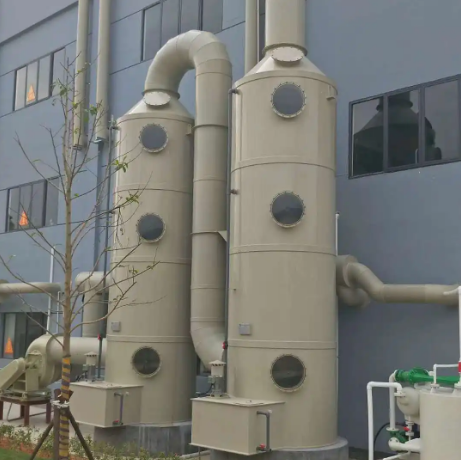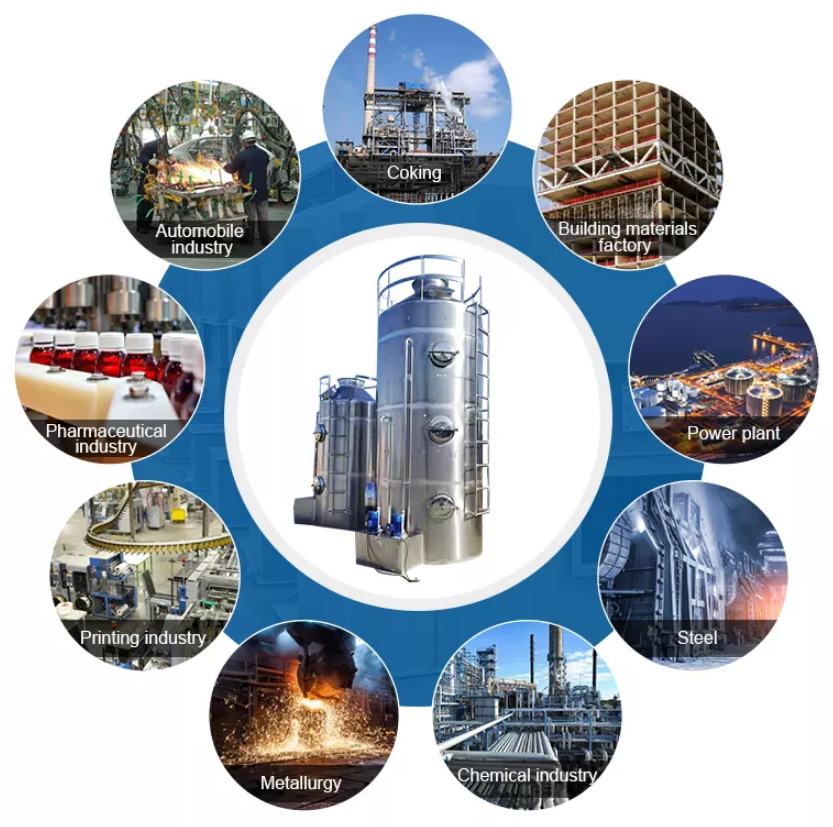et scrubber, also known as a wet scrubber system, is an air pollution control device used to remove particles, gases, or other pollutants from industrial exhaust gases or air streams. It operates by using a liquid (usually water) to capture and neutralize contaminants present in the gas stream, effectively cleaning the air before it is released into the environment.

The basic principle of a wet scrubber involves bringing the contaminated gas stream into contact with a liquid spray, creating a “scrubbing” action that facilitates the transfer of pollutants from the gas phase to the liquid phase. The pollutants are either dissolved in the liquid or removed through physical processes like impaction, diffusion, or adhesion.
The working principle of the wet scrubber of the exhaust gas treatment equipment: the pickling equipment produces a large amount of acid mist exhaust gas, the main component is hydrochloric acid. The acid mist exhaust gas is pumped into the wet scrubber by the fan through the arranged air duct (it has the characteristics of small exhaust gas flow, low wind resistance, full contact between exhaust gas and lye, and good treatment effect). The gas moves at high speed from bottom to top, and from top to top. Under contact with washing liquid. As the tower is equipped with multi-layer pull ring packing, the gas-liquid contact area and contact time are increased, so that the gas-liquid fully contacts the surface of the tray in the tower.
In the process of contact with spray water, the pollutant carbon black in the exhaust gas is fully absorbed by the water and can be purified; the gaseous pollutants such as HCl in the exhaust gas are added to the spray water by adding a certain proportion of NaOH to make the spray water alkaline Sex. In the spraying process, when the water contacts the exhaust gas, a biochemical reaction will occur to neutralize gaseous pollutants such as HCl and achieve a good treatment effect. In the entire exhaust gas purification process, the equipment does not need to be cleaned, the spray water used can be recycled, the entire treatment process can be automatically controlled, and the operation is simple.
The circulating water pump pumps the liquid medicine in the circulating water tank to the upper part of the tower for spraying. Due to the special spiral nozzle and the special tower structure, the liquid medicine from the nozzle can reach a completely atomized state, form a fine water mist, and form complete contact with the upstream gas. The water molecules fully absorb the HCl in the gas through van der Waals force and intermolecular gravity to achieve the purpose of purification. The purified gas is directly discharged from the exhaust pipe on the top of the wet scrubber, and the washing liquid enters the circulation after being precipitated in the sedimentation tank. The water tank is discharged through the exhaust pipe on the top of the wet scrubber and the spray water is lifted and recycled by the circulating pump.
The spray water circulation system is equipped with an automatic pH value monitoring system, which can monitor the pH value of the circulating water online, automatically control the amount of alkali added, keep the pH value constant, and ensure the stable operation of the system. Taking into account the strong acidity of HCl-containing gas and daily use, the wet scrubber equipment uses polypropylene, and the circulating water pump uses FRPP. Chemical reaction: decentralized pollution “refers to companies that do not comply with industrial policies and industrial layout plans, have safety, fire-fighting hazards, and pollutant discharge standards, enterprises with incomplete procedures for industrial and commercial, environmental protection, land, planning, and safety supervision, fire protection, power, etc. (especially Enterprises, industrial stalls and small industrial plants in residential areas).

Mainly including but not limited to: non-ferrous metal smelting and processing, rubber production, tanning, chemical industry, ceramic firing, casting, wire mesh processing, steel rolling, refractory materials, carbon production, lime kiln, brick kiln, cement grinding station, waste plastic processing, Small oil refining, glass manufacturing, textile printing and dyeing, synthetic fiber manufacturing, printing, surface coating, furniture, shoemaking, auto repair, catering and food processing, stone processing, waste recycling, wood-based panel manufacturing, electronic component manufacturing, acid Small-scale manufacturing, and processing enterprises such as washing, phosphating, etc.; small enterprises or processing sites involving the use of coatings, paints, inks, adhesives, and organic solvents.